Sharannavaratri Celebrations 2014
The Sharada Sharan Navaratri Celebrations of the Jaya Samvatsara began with the performance of Mahabhisheka to Goddess Sharadamba on Mahalaya Amavasya (24th September 2014). Jagadguru Shankaracharya Sri Sri Bharati Tirtha Mahaswamiji arrived at the temple of Goddess Sharadamba just before noon. Mahamangalarati was performed to Goddess Sharadamba who sported the Jagat Prasutika Alankara.
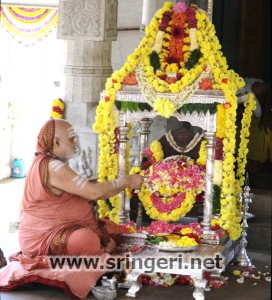
Jagadguru performs a Puja as part of Sharada Pratishtha on the first daty of Navaratri
On 25th September, Jagadguru Shankaracharya Sri Sri Bharati Tirtha Mahaswamiji performed Sharada Prathistha and then performed special Puja to Goddess Sharadamba. Goddess Sharadamba sported a number of Alankaras such as Hamsavahini (Brahmi), Rishabhavahini (Maheshwari), Mayuravahini (Kaumari), Garudavahini (Vaishnavi), Mohini, Veena Sharada, Simhavahini, Rajarajeshwari, Gajalakshmi, Kamadhenu Alankara, Indrani and Bhuvaneshwari. Every day in the mornings, the Jagadguru offered a special Puja to Goddess Sharadamba. Lakhs of devotees visited Sringeri and offered worship during Navaratri.
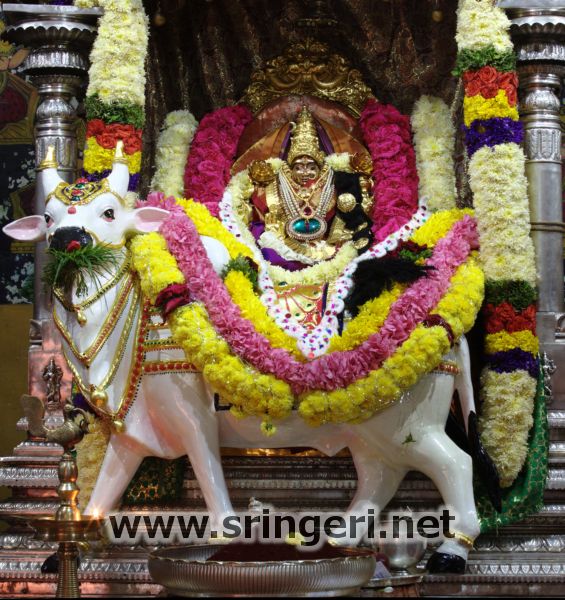
Utsava Murti of Goddess Sharadamba in Maheshwari Alankara
Shatachandi Mahayaga commenced on Panchami for the welfare of mankind. On Mahanavami, the Poornahuti of the Shatachandi Yaga was completed in the presence of Jagadguru Mahaswamiji. The Gaja Puja and Ashwa Puja were performed in the Jagadguru’s presence. Ayudha Puja and Vahana Puja also took place.
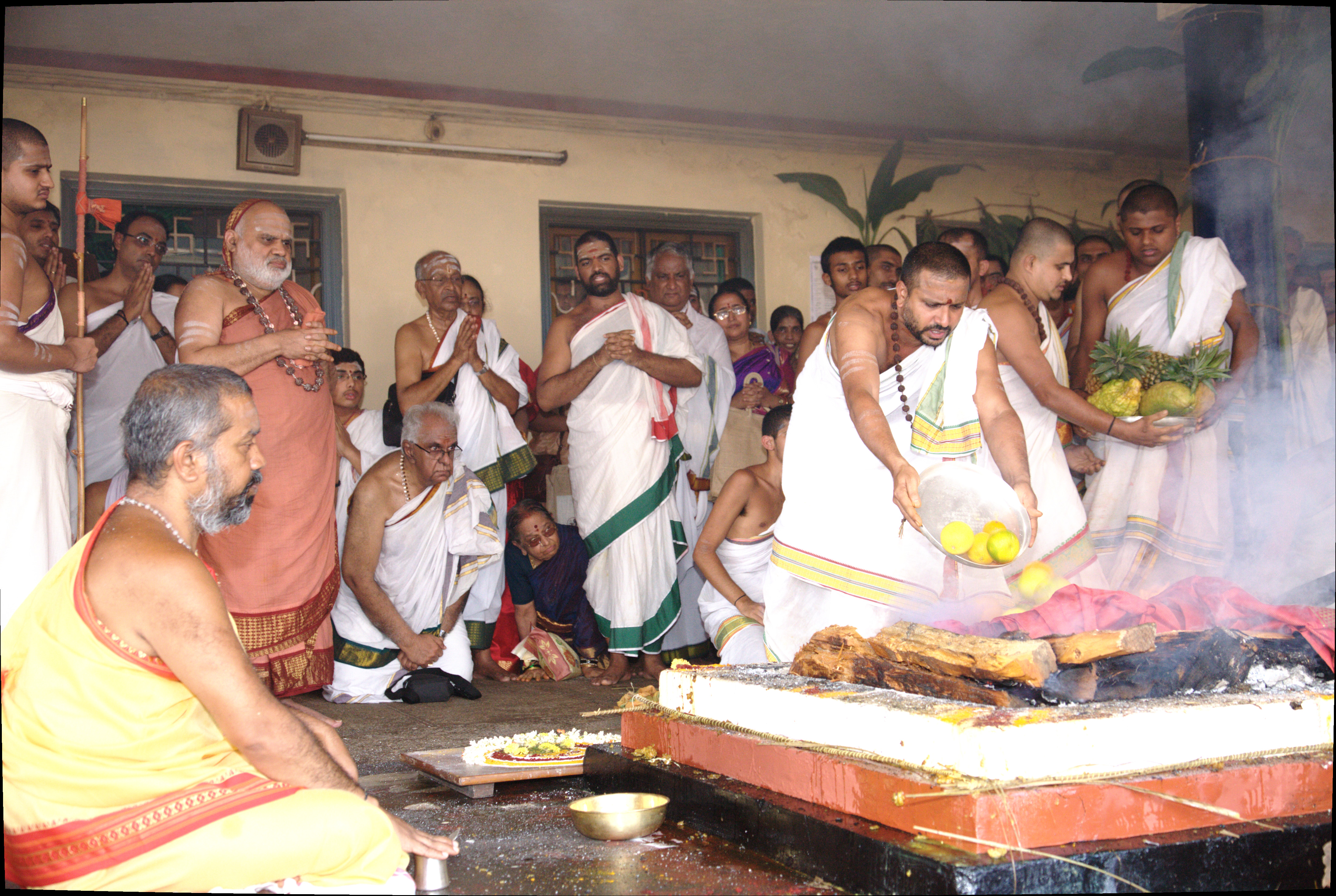
Poornahuti of Shatachandi Mahayaga in the Jagadguru’s presence
During the Navaratri festival, Parayana of the four Vedas, the commentaries on Vedanta (Prasthana-traya Bhashya of Sri Adi Shankaracharya), Sri Devi Bhagavatam, Sri Devi Mahatmyam, Ramayanam, Srimad Bhagavatam, Sri Vishnu Puranam, Sri Harivamsha Puranam, Sri Madhaviya Shankara Vijayam, etc. took place.
Every evening, Laksharchana was performed inside the temple. The Utsava Moorti of Goddess Sharada was taken in a Dindi Utsava along the main streets of Sringeri to the accompaniment of Veda Ghosha and the singing of bhajans by various groups. Also exquisitely decorated with the various Alankaras were the Utsava Moorti of Goddess Sharadamba as well as the Vigraha of Goddess Sharadamba worshipped as part of the daily Sharada Chandramoulishwara Puja performed by the Jagadguru.
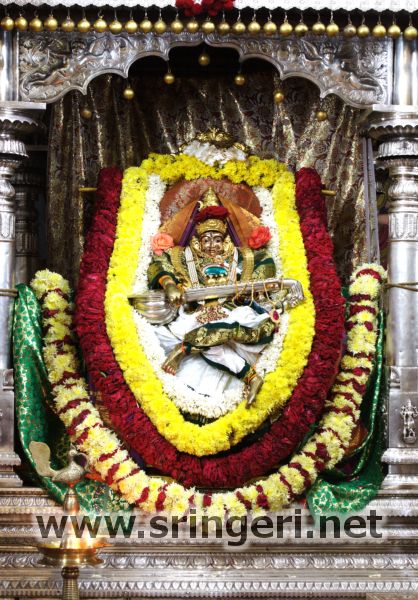
Goddess Sharadamba (Utsava Murti) seated on the Vyakhyana Simhasana
Every night after the Chandramoulishwara Puja, the Jagadguru in accordance to the centuries-old tradition adorned royal attire, conducted the Golden Dindi Utsava of Goddess Sharada in the temple and held the Navaratri Durbar. During the Durbar, Sri Durga Sapta Shati Parayanam (by Vyakarana Vidwan Sri Vinayaka Udupa of Sadvidya Sanjeevini Samskrita Mahapathashala) took place followed by Ashtavadhana Seva and Panchanga Pathanam. On the night of Moola Nakshatra, when the Goddess was decorated as Veena Sharada, offerings of various royal scions including those of Mysore, Gwalior, Indore, Jamakhandi, Thiruvananthapuram, Kashi, Nepal were placed by the CEO & Administrator Sri V R Gowrishankar.
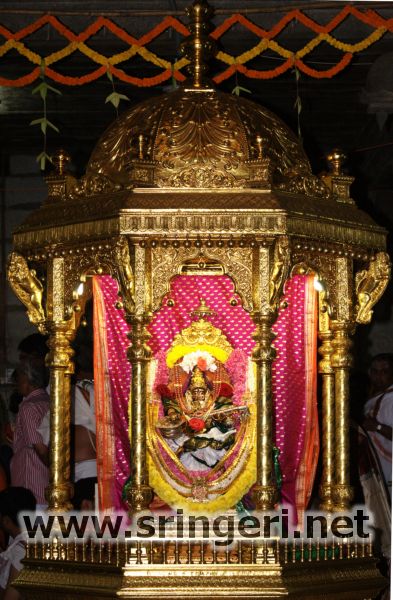
Goddess Sharadamba (Utsava Murti) in Golden Ratha
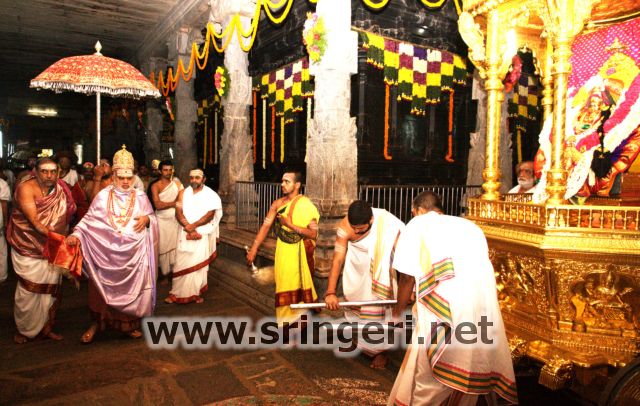
Golden Rathotsava of Goddess Sharadamba during Navaratri
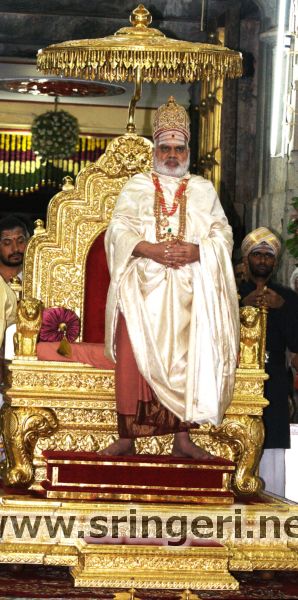
Jagadguru in Durbar witnessing the Mahamangalarati to Goddess Sharadamba
Throughout the Navaratri festival, music artistes offered Seva to the Goddess and the Jagadguru by performing at the Jagadguru Sri Chandrashekhara Bharati Sabha Bhavanam.
On Vijayadashami (October 3rd), the Jagadguru performed the Parayana of the Pattabhisheka Sarga of Srimad Valmiki Ramayanam. The Jagadguru then inaugurated a website – http://stotra.sringeri.net – developed by Sri R. Sivaramakrishna Sharma of Sri Shankara Advaita Research Centre of the Peetham. Speaking on the occasion, Administrator & CEO, Sri V R Gowrishankar mentioned that the website will serve as a virtual gurukulam to everyone who wishes to learn stotras with proper pronunciation. The website not only contains stotras but also comes with two types of audio for each stotra. The first is a verse by verse chanting of the Stotras. The second audio contains a line-by-line teaching of every verse of the Stotras. Sri Gowrishankar said that with very few people chanting Stotras today and with even fewer teaching Stotras to the younger generation, the website would serve as a great boon to everyone interested in learning Stotras. The stotras are available in various scripts including Devanagari, Kannada, Telugu, Malayalam, Gujarati and Roman (with diacritics).
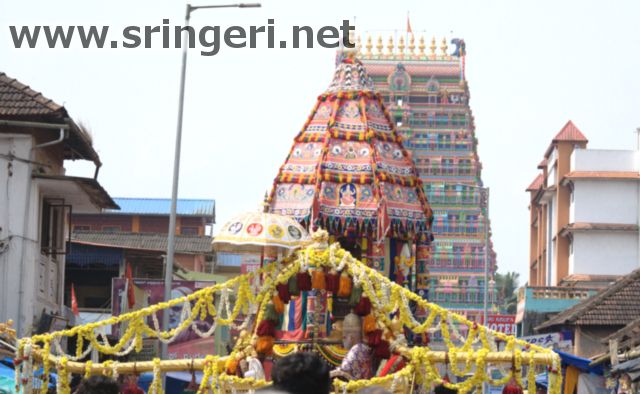
Adda Pallakki and Sharadamba Maharathotsava
On Ekadashi (October 4th), the Sharadamba Maharathotsava and the Adda Pallakki Utsava took place. Watched by a huge gathering of devotees, the Jagadguru was reverentially carried in the Golden Adda Pallakki (palanquin) in front of the Ratha. It was a sight to behold the Adda Pallakki carrying the Jagadguru passing through the majestic Rajagopuram for the first time. The Rathotsava turned out to be a grand feast to the eyes and ears of thousands of devotees. The two hour event featured Vedic chanting by scholars and students, Bhajans by various groups of devotees, exhibition of various tableaus (featuring themes as Lord Shiva in Tandava, worship of Go Mata, historic monuments), folk dance troops and bands from other states such as Kerala and Maharashtra. This was followed by Durbar at the temple of Goddess Sharada after which the Jagadguru distributed Tirtha Prasada to all those assembled.
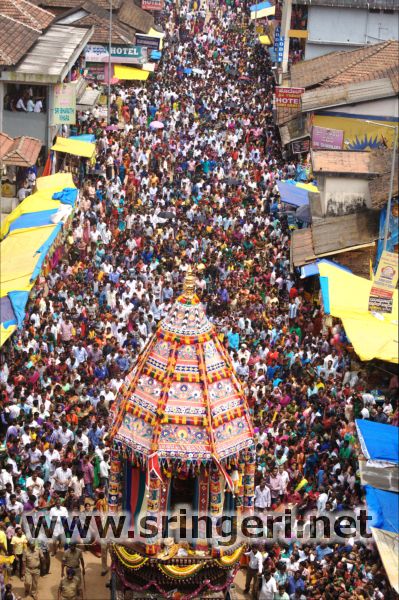
Sharadamba Maharathotsava
The events of Navaratri were telecast live on Sri Sankara TV on all days and on ETV Kannada on select days. From the first day of Navarartri to the Ekadashi day, the Jagadguru Mahaswamiji performed the regular Chandramoulishwara Puja on the northern side of the Tunga in the first floor of the building “Sharada Prasada”. From Dwadashi onwards, the Jagadguru resumed performing the Chandramoulishwara Puja at Guru Nivas in Narasimhavanam. From Dwadashi to Poornima, the Jagadguru Mahaswamiji had Darshan at Sri Sharadamba Sannidhi every morning. The Sharannavaratri Celebrations ended with Mahabhishekha of the Goddess on Poornima (October 8th) followed by Teppotsava in the evening.
